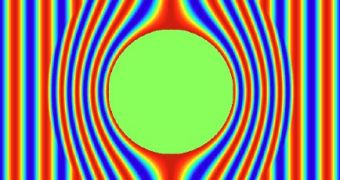Let's not fool ourselves, invisibility cloaks have been built and they do exist; they don't work exactly as they should is another thing. However, Duke University researchers said they hadn't done enough to improve the technology and decided to test some acoustic invisibility devices before resuming the work on the electromagnetic ones.
Their previous demonstration of the invisibility cloak apparently proved that they can only hide objects when viewed in the microwave spectrum and present only 2D cloaking capabilities. The universe has three dimensions however, not two. Invisibility cloaks work by literally stopping the light a source emits from reaching the surface of the device, so the light is not reflected. If the light is not reflected on the surface of a body, then you cannot see it.
Researchers stated last week that they had been successful in creating a mathematical model of an acoustic cloak as well, but, at the time, failed to provide with additional information on how the device would actually work. The principle is rather simple: they either cause the sound vibrations to be absorbed into the surface of the cloak or find a way to bend the sound waves around it.
It looks like the researchers from Duke University have chosen the second possibility. Not because it is the simplest, but it enables the use of metamaterials, the same materials used in the design of the invisibility cloak. Metamaterials represent a special class of materials, constructed of an intricate metal structure that would bend waves in an unique way.
Considering that both light and sound are propagated through the medium by means of waves, constructing a mathematical model of the acoustic cloak was not so hard as it may seem, owing to the past experience with electromagnetic cloaks. Nevertheless, theory is not always reality!
As expected, the cylindrical cloak model of the acoustic cloak would only be efficient while waves propagating through the medium hit it on a direction perpendicular to that of the cylinder's axis, thus forming a 2D cloak, the same problem experienced with electromagnetic cloaks.
But unlike invisibility cloaks which seem to present preferential wavelengths, the acoustic cloak might work in the broad band of sound frequencies. The mathematical model of the 3D cloak suggests that the used metamaterial could be constructed by creating a matrix of cylindrical rods, with variable radii and spacings out of a material with special elastic features, but is yet unknown what kind of substance would have such characteristics.
Since the cloak is constructed of cylindrical rods, the spaces between them would allow the air, water or any type of substance in the medium to slip through the rods, making it functional in different materials.

 14 DAY TRIAL //
14 DAY TRIAL //